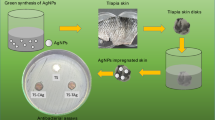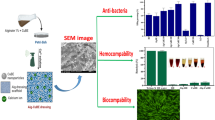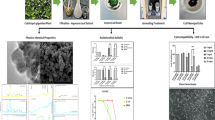Abstract
The development of microbial biofilm occurs with the adherence of the microbial cells on biotic and abiotic surfaces with the help of pili and with extracellular polymeric substances. The surfaces on which biofilm formation take place can be inert, abiotic, or biotic. The sessile microbial cells behave differently from their planktonic counterpart. The biofilm developed by Alcaligenes faecalis is responsible for the development of skin and soft-tissue infection. It was observed that green-synthesized carbon nanoparticles (NPs) from Ocimum sanctum showed a prolonged stability and activity. It showed a marked reduction in the viability of sessile microbial species with least revival in comparison to the plant extract and amoxicillin. It was observed that carbon NP was able to maximally reduce the quorum sensing (QS) activity of A. faecalis. Thus, the use of green-synthesized NPs would be an alternative in the treatment of the biofilm-associated chronic wound infections.








Similar content being viewed by others
Data Availability
The data used to support the findings of this study are available from the corresponding author upon request.
References
Lahiri, D., Dash, S., Dutta, R., et al. (2019). Elucidating the effect of anti-biofilm activity of bioactive compounds extracted from plants. Journal of Biosciences, 44, 52. https://doi.org/10.1007/s12038-019-9868-4
Lahiri, D., et al. (2021). Biofilm and antimicrobial resistance. In R. R. Ray, M. Nag, & D. Lahiri (Eds.), Biofilm-mediated diseases: causes and controls. Singapore: Springer. https://doi.org/10.1007/978-981-16-0745-5_8
Nag, M., Lahiri, D., Dutta, B., et al. (2021). Biodegradation of used polyethylene bags by a new marine strain of Alcaligenes faecalis LNDR-1. Environmental Science and Pollution Research, 28, 41365–41379. https://doi.org/10.1007/s11356-021-13704-0
Shoda, M., et al. (2020). Alcaligenes. Beneficial microbes in agro-ecology (pp. 13–26). Amsterdam: Academic Press. https://doi.org/10.1016/b978-0-12-823414-3.00002-2
Patra, J. K., Das, G., Fraceto, L. F., Campos, E., Rodriguez-Torres, M., Acosta-Torres, L. S., Diaz-Torres, L. A., Grillo, R., Swamy, M. K., Sharma, S., Habtemariam, S., & Shin, H. S. (2018). Nano based drug delivery systems: Recent developments and future prospects. Journal of Nanobiotechnology, 16(1), 71.
Lahiri, D., Nag, M., Dutta, B., Dash, S., Ghosh, S., & Ray, R. (2021). Synergistic effect of quercetin with allicin from the ethanolic extract of Allium cepa as a potent antiquorum sensing and anti-biofilm agent against oral biofilm. In D. Ramkrishna, S. Sengupta, Bandyopadhyay S. Dey, & A. Ghosh (Eds.), Advances in bioprocess engineering and technology. Lecture Notes in Bioengineering. Singapore: Springer.
Jeyaseelan, E. C., & Jashothan, P. T. (2012). In vitro control of Staphylococcus aureus (NCTC 6571) and Escherichia coli (ATCC 25922) by Ricinus communis L. Asian Pacific Journal of Tropical Biomedicine, 2(9), 717–721.
Khalilzadeh, M. A., & Borzoo, M. (2016). Green synthesis of silver nanoparticles using onion extract and their application for the preparation of a modified electrode for determination of ascorbic acid. Journal of Food and Drug Analysis, 24(4), 796–803.
Tiwari, V., Mishra, N., Gadani, K., Solanki, P. S., Shah, N. A., & Tiwari, M. (2018). Mechanism of anti-bacterial activity of zinc oxide nanoparticle against Carbapenem-resistant Acinetobacter baumannii. Frontiers in Microbiology, 9, 1218.
**i, D., & Sharmila, S. (2019). Green synthesis of silver nanoparticles from Allium cepa and its in vitro antidiabetic activity. Materials Today: Proceedings, 22(3), 432–438.
Vu, B., Chen, M., Crawford, R. J., & Ivanova, E. P. (2009). Bacterial extracellular polysaccharides involved in biofilm formation. Molecules, 14(7), 2535–2554.
Conway, B. A., Venu, V., & Speert, D. P. (2002). Biofilm formation and acyl homoserine lactone production in the Burkholderia cepacia complex. Journal of Bacteriology, 184(20), 5678–5685.
Gala, V. C., John, N. R., Bhagwat, A. M., Datar, A. G., Kharkar, P. S., & Desai, K. B. (2016). Attenuation of quorum sensing-regulated behaviour by Tinospora cordifolia extract & identification of its active constituents. The Indian Journal of Medical Research, 144(1), 92–103. https://doi.org/10.4103/0971-5916.193295
Krishnaraj, C., Jagan, E. G., Rajasekar, S., Selvakumar, P., Kalaichelvan, P. T., & Mohan, N. (2010). Synthesis of silver nanoparticles using Acalypha indica leaf extracts and its antibacterial activity against water borne pathogens. Colloids and Surfaces B Biointerfaces, 76, 50–56.
Rajendran, N. K., George, B. P., Houreld, N. N., & Abrahamse, H. (2021). Synthesis of zinc oxide nanoparticles using Rubus fairholmianus root extract and their activity against pathogenic bacteria. Molecules (Basel, Switzerland), 26(10), 3029. https://doi.org/10.3390/molecules26103029
Vijayalakshmi, U., Chellappa, M., Anjaneyulu, U., Manivasagam, G., & Sethu, S. (2016). Influence of coating parameter and sintering atmosphere on the corrosion resistance behavior of electrophoretically deposited composite coatings. Materials and Manufacturing Processes, 31, 95–106. https://doi.org/10.1080/10426914.2015.1070424
Selim, Y. A., Azb, M. A., Ragab, I., et al. (2020). Green synthesis of zinc oxide nanoparticles using aqueous extract of Deverra tortuosa and their cytotoxic activities. Science and Reports, 10, 3445. https://doi.org/10.1038/s41598-020-60541-1
Jamdagni, P., Khatri, P., & Rana, J. (2018). Green synthesis of zinc oxide nanoparticles using flower extract of Nyctanthes arbor-tristis and their antifungal activity. Journal of King Saud University - Science, 30, 168–175. https://doi.org/10.1016/j.jksus.2016.10.002
Taş, A. C., Majewski, P. J., & Aldinger, F. (2000). Chemical preparation of pure and strontium-and/or magnesium-doped lanthanum gallate powders. Journal of the American Ceramic Society, 83, 2954–2960. https://doi.org/10.1111/j.1151-2916.2000.tb01666.x
Sangeetha, G., Rajeshwari, S., & Venckatesh, R. (2011). Green synthesis of zinc oxide nanoparticles by aloe barbadensis miller leaf extract: Structure and optical properties. Materials Research Bulletin, 46, 2560–2566. https://doi.org/10.1016/j.materresbull.2011.07.046
Jan, H., Shah, M., Usman, H., Khan, M. A., Zia, M., Hano, C., & Abbasi, B. H. (2020). Biogenic synthesis and characterization of antimicrobial and antiparasitic zinc oxide (ZnO) nanoparticles using aqueous extracts of the Himalayan Columbine (Aquilegia pubiflora). Frontiers in Materials, 7, 249.
Singh, A., Gautam, P. K., Verma, A., Singh, V., Shivapriya, P. M., Shivalkar, S., Sahoo, A. K., & Samanta, S. K. (2020). Green synthesis of metallic nanoparticles as effective alternatives to treat antibiotics resistant bacterial infections: a review. Biotechnology Reports (Amsterdam, Netherlands), 25, e00427. https://doi.org/10.1016/j.btre.2020.e00427
Gunalan, S., Sivaraj, R., & Rajendran, V. (2012). Green synthesized ZnO nanoparticles against bacterial and fungal pathogens. Progress in Natural Science: Materials International, 22(6), 693–700.
Divya, M., Vaseeharan, B., Abinaya, M., Vijayakumar, S., Govindarajan, M., Alharbi, N. S., Kadaikunnan, S., Khaled, J. M., & Benelli, G. (2018). Biopolymer gelatin-coated zinc oxide nanoparticles showed high antibacterial, antibiofilm and anti-angiogenic activity. Journal of Photochemistry and Photobiology B: Biology, 178, 211–218. https://doi.org/10.1016/j.jphotobiol.2017.11.008
Al-Shabib, N. A., Husain, F. M., Ahmed, F., Khan, R. A., Ahmad, I., Alsharaeh, E., Khan, M. S., Hussain, A., Rehman, M. T., Yusuf, M., Hassan, I., Khan, J. M., Ashraf, G. M., Alsalme, A., Al-Ajmi, M. F., Tarasov, V. V., & Aliev, G. (2016). Biogenic synthesis of zinc oxide nanostructures from Nigella sativa seed: prospective role as food packaging material inhibiting broad-spectrum quorum sensing and biofilm. Scientific Reports, 6(1), 36761. https://doi.org/10.1038/srep36761
Fan, Z., & Lu, J. G. (2005). Zinc oxide nanostructures: Synthesis and properties. Journal of Nanoscience and Nanotechnology, 5(10), 1561–1573.
Franklin, N. M., Rogers, N. J., Apte, S. C., et al. (2007). Comparative toxicity of nanoparticulate ZnO, bulk ZnO, and ZnCl2 to a freshwater microalga (Pseudokirchneriella subcapitata): The importance of particle solubility. Environmental Science and Technology, 41(24), 8484–8490.
Author information
Authors and Affiliations
Corresponding author
Additional information
Publisher's Note
Springer Nature remains neutral with regard to jurisdictional claims in published maps and institutional affiliations.
Rights and permissions
Springer Nature or its licensor (e.g. a society or other partner) holds exclusive rights to this article under a publishing agreement with the author(s) or other rightsholder(s); author self-archiving of the accepted manuscript version of this article is solely governed by the terms of such publishing agreement and applicable law.
About this article
Cite this article
Yang, M., Li, Z. Development of Green-Synthesized Carbon-Based Nanoparticle for Prevention of Surface Wound Biofilm. Appl Biochem Biotechnol (2023). https://doi.org/10.1007/s12010-023-04695-4
Accepted:
Published:
DOI: https://doi.org/10.1007/s12010-023-04695-4




